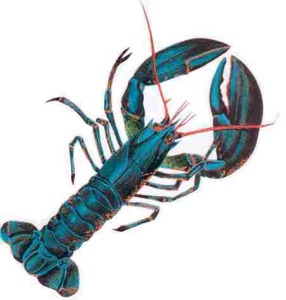 Salvador Dali disait que ce crustacé était très malin car sa chair étant fragile il avait préféré mettre ses os à l’extérieur ! Et puis, les esprits fins étant fait pour s’unir, le grand poète Gérard de Nerval, lui, se promenait avec un homard tenu en laisse ! Qui est donc ce splendide animal, souvent invité de nos réveillons, dont le destin est d’être ébouillanté vivant avant de se faire déguster ! Le homard se distingue facilement, par exemple, de la langouste par la présence de ses énormes pinces, l’une pour couper, l’autre pour broyer. Le homard vit à la limite des zones découvertes aux grandes marées où il creuse un « terrier jusqu’à 50 mètres de profondeur. La femelle pond jusqu’à 100 000 œufs au cours de sa vie et les « couve » sous son abdomen. Le homard juvénile subira une vingtaine de mues de croissance avant d’atteindre l’âge adulte, vers l’âge de cinq ans. Il peut mesurer 50 cm et peser 4 kg. En France, les homards de première qualité se trouvent en Bretagne et dans la Manche. Le plus réputé est le « homard bleu sauvage », C’est une espèce en forte raréfaction, ce qui ne fut pas toujours le cas. Sachez, ainsi, que le homard était si commun au XVIIIe siècle qu’il était la nourriture des pauvres. Les Etats Unis avaient même voté une loi interdisant son utilisation plus que deux fois par semaine car manger du homard était jugé comme un châtiment cruel infligé aux prisonniers, aux esclaves et aux domestiques ! Aujourd’hui, tout cela a bien changé et le homard est un luxe.
Salvador Dali disait que ce crustacé était très malin car sa chair étant fragile il avait préféré mettre ses os à l’extérieur ! Et puis, les esprits fins étant fait pour s’unir, le grand poète Gérard de Nerval, lui, se promenait avec un homard tenu en laisse ! Qui est donc ce splendide animal, souvent invité de nos réveillons, dont le destin est d’être ébouillanté vivant avant de se faire déguster ! Le homard se distingue facilement, par exemple, de la langouste par la présence de ses énormes pinces, l’une pour couper, l’autre pour broyer. Le homard vit à la limite des zones découvertes aux grandes marées où il creuse un « terrier jusqu’à 50 mètres de profondeur. La femelle pond jusqu’à 100 000 œufs au cours de sa vie et les « couve » sous son abdomen. Le homard juvénile subira une vingtaine de mues de croissance avant d’atteindre l’âge adulte, vers l’âge de cinq ans. Il peut mesurer 50 cm et peser 4 kg. En France, les homards de première qualité se trouvent en Bretagne et dans la Manche. Le plus réputé est le « homard bleu sauvage », C’est une espèce en forte raréfaction, ce qui ne fut pas toujours le cas. Sachez, ainsi, que le homard était si commun au XVIIIe siècle qu’il était la nourriture des pauvres. Les Etats Unis avaient même voté une loi interdisant son utilisation plus que deux fois par semaine car manger du homard était jugé comme un châtiment cruel infligé aux prisonniers, aux esclaves et aux domestiques ! Aujourd’hui, tout cela a bien changé et le homard est un luxe.
La plupart des amateurs l’accompagnent de beurre à l’ail, de citron ou de mayonnaise. On peut le manger tel quel, en aspic ou en salade, mais aussi en sauce au cidre, au vin, au champagne ou même à l’anis… Sa carapace parfume les bisques, les soupes de poissons, les ragoûts ou les sauces. Pour manger la chair de ses pattes, il existe une technique très simple: les casser au ras du corps en tirant dessus, puis à l’aide d’une paire de ciseau couper l’endroit où la patte tenait à la carapace et utiliser un rouleau à pâtisserie pour que la chair sort toute seule, en un long et fin cylindre. Pas pratique lors d’un dîner mondain, mais très efficace ! Pour terminer, voyons la recette du court bouillon au homard. Sans doute, l’une des plus célèbres. Voici les ingrédients que je recommande, pour un homard moyen fournissant, environ, six litres de court-bouillon : cinq litres d’eau, une demi bouteille de Mareuil, une cuillerée à soupe de vinaigre de vin, quelques carottes tranchées en rondelles obliques de 2 cm d’épaisseur, un oignon clouté , une feuille de laurier – pas plus !, trois brindilles d’estragon frais, cinq grains de poivre noir et cinq cuillerées à soupe de fleur de sel. Puis, chauffer le court-bouillon pour arriver au point d’ébullition. Retirer les élastiques qui maintenaient fermées les pinces du homard, puis le plonger dans l’eau la tête la première. Laisser remonter en température puis frissonner pendant un temps proportionnel [à la masse du homard. Dans le doute, mieux vaut raccourcir le temps de cuisson, sinon la chair devient filandreuse. Servez vite et bon appétit !
My dear Lobster, gastronomic King
 Salvador Dali used to say that this crustacean was very clever because, his flesh being fragile, he preferred his skeleton to be on the outside! And, since great minds think alike, the poet Gérard de Nerval used to have a pet lobster that he took for walks on a lead! So just who is this splendid creature, often invited for special occasions, and whose destiny is to be boiled alive before ending up on our plates! Lobster is easily distinguishable from crayfish, for example, by its huge claws, one for cutting and the other for grinding. The lobster lives at the limit of zones that are revealed by extreme tide changes where he burrows down to up to 50 metres below the sand. The female lays up to 100,000 eggs during her lifetime and shelters them under her abdomen until they hatch. Young lobsters go through around twenty growth moults before reaching adulthood when they are five years old. They can measure up to 50cm and weigh up to 4kg. In France, the best quality lobsters come from the Brittany coast and the English Channel. The most famous is the wild blue lobster. Sadly it is a species that is dying out fast, which was not always the case. Indeed the lobster was so common in the 18th century that it was the food of the poor. The United States even voted a law prohibiting it from being eaten more than twice a week because eating lobster was considered as a cruel punishment inflicted on prisoners, slaves and servants! Today all that has changed and the lobster is considered as a delicacy.
Salvador Dali used to say that this crustacean was very clever because, his flesh being fragile, he preferred his skeleton to be on the outside! And, since great minds think alike, the poet Gérard de Nerval used to have a pet lobster that he took for walks on a lead! So just who is this splendid creature, often invited for special occasions, and whose destiny is to be boiled alive before ending up on our plates! Lobster is easily distinguishable from crayfish, for example, by its huge claws, one for cutting and the other for grinding. The lobster lives at the limit of zones that are revealed by extreme tide changes where he burrows down to up to 50 metres below the sand. The female lays up to 100,000 eggs during her lifetime and shelters them under her abdomen until they hatch. Young lobsters go through around twenty growth moults before reaching adulthood when they are five years old. They can measure up to 50cm and weigh up to 4kg. In France, the best quality lobsters come from the Brittany coast and the English Channel. The most famous is the wild blue lobster. Sadly it is a species that is dying out fast, which was not always the case. Indeed the lobster was so common in the 18th century that it was the food of the poor. The United States even voted a law prohibiting it from being eaten more than twice a week because eating lobster was considered as a cruel punishment inflicted on prisoners, slaves and servants! Today all that has changed and the lobster is considered as a delicacy.
Most lobster fans tend to eat it with garlic butter, lemon or mayonnaise. But it can also be enjoyed as it is, in aspic or in a salad, as well as in a cider, a wine, a champagne or even an aniseed sauce … Its shell is used to flavour bisques, fish soups, stews and sauces. There is a very simple technique to get to the flesh inside its claws which is to break them close to the body by pulling on them, then using scissors to cut the place where the claw was attached to the body and hitting the claws with a rolling pin to extract the flesh, which will come out in a long thin cylinder. Not very practical at a high society dinner, but very effective nonetheless! To finish, let’s look at the recipe for making lobster stock. It is undoubtedly one of the most famous. Here are the ingredients that I recommend, for an average sized lobster which can make around litres of stock: five litres of water, a half-bottle of Mareuil, a tablespoon of wine vinegar, a couple of carrots cut into 2cm thick oval slices, an onion studded with cloves, one bay leaf – no more!, three sprigs of fresh tarragon, five grains of black pepper and five tablespoons of good quality salt. Then, heat the stock until it reaches boiling point. Remove the elastic bands that were immobilising the lobster’s claws and plunge it head first into the pan. Let the temperature rise so that the stock simmers for the time necessary according to the weight of the lobster. If in doubt, it is better to undercook it rather than overcook it, otherwise the flesh becomes stringy. Serve quickly and enjoy!
Didier MOINEL DELALANDE







